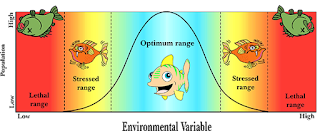Hyrarchi of Ecology
Ecological hierarchy theory describes the arrangement of biological organisms in relation to one another.
1. Individuals
The first level of the ecological hierarchy is the individual organism. This level of the hierarchy examines how one organism interacts with its environment. Aspects of evolution are used extensively in studying this level. For example, the individual-organism level allows a scientist to study why a giraffe has a very long neck. He can infer that evolution has given the giraffe the long neck so it can reach a food source high on a tree. Organismal ecology is concerned with the biological, morphological and physiological development of individual organisms in response to their natural environment.
1. Individuals
The first level of the ecological hierarchy is the individual organism. This level of the hierarchy examines how one organism interacts with its environment. Aspects of evolution are used extensively in studying this level. For example, the individual-organism level allows a scientist to study why a giraffe has a very long neck. He can infer that evolution has given the giraffe the long neck so it can reach a food source high on a tree. Organismal ecology is concerned with the biological, morphological and physiological development of individual organisms in response to their natural environment.
2. Populations
The second level involves populations. A population contains a group of individuals -- belonging to one species and living in a specific geographic area -- which interact with one another. Population ecology studies the interactions among the individual members of a population.
The second level involves populations. A population contains a group of individuals -- belonging to one species and living in a specific geographic area -- which interact with one another. Population ecology studies the interactions among the individual members of a population.
3. Communities
The third level of the ecological hierarchy describes communities of life. The community level focuses on the relationship between different species in a community. Predator and prey relationships play a large role in community-level analyses. Parasitism and competition between species are another important part of this ecological level.
The third level of the ecological hierarchy describes communities of life. The community level focuses on the relationship between different species in a community. Predator and prey relationships play a large role in community-level analyses. Parasitism and competition between species are another important part of this ecological level.
4. Ecosystems
The next level up is an ecosystem. A community is part of an ecosystem, but does not comprise an entire ecosystem. Nonliving components in the environment are included in an ecosystem. The living organisms in an ecosystem interact with one another and with the nonliving factors in the environment. Examples of an ecosystem include a single lake, a confined forest, a prairie or a mountain summit.
The next level up is an ecosystem. A community is part of an ecosystem, but does not comprise an entire ecosystem. Nonliving components in the environment are included in an ecosystem. The living organisms in an ecosystem interact with one another and with the nonliving factors in the environment. Examples of an ecosystem include a single lake, a confined forest, a prairie or a mountain summit.
5. Biosphere
At the widest level of analysis, the biosphere represents the totality of all things on Earth, including their interactions. The biosphere includes all ecosystems on Earth and how they interact together. By default, the biosphere includes climate, geology, the oceans and human pollution. This level of analysis can seem abstract, but it frequently has practical applications. Global climate change, for example, examines how the destruction of one ecosystem -- like the Amazon rainforest -- can lead to a loss of global climate regulation, and affect life on a part of Earth distant from the Amazon.
At the widest level of analysis, the biosphere represents the totality of all things on Earth, including their interactions. The biosphere includes all ecosystems on Earth and how they interact together. By default, the biosphere includes climate, geology, the oceans and human pollution. This level of analysis can seem abstract, but it frequently has practical applications. Global climate change, for example, examines how the destruction of one ecosystem -- like the Amazon rainforest -- can lead to a loss of global climate regulation, and affect life on a part of Earth distant from the Amazon.
http://education.seattlepi.com/ecological-hierarchy-4489.html




sudah bagus, penjelasan sudah lengkap, terdapat contoh juga, gambarpun juga ditampilkan, untuk penulisan daftar rujukan diperbaiki lagi ya.
BalasHapusNice Information Ais
BalasHapusSemangat terus untuk menulis di blog walaupun sudah lulus matakuliah ekologi